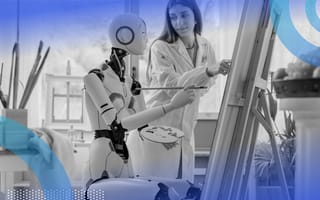The application of AI in creative arts and creative hypothesis generation in science and design is nothing new, but it has amped up tremendously in recent years with the advent of deep neural nets trained on vast volumes of human creative products.
When I introduced the term artificial general intelligence (AGI) in 2005, I had already been experimenting with AI for creative arts for two and a half decades. Watching how the intersection of AI and creativity has evolved over the course of my career, I have observed a striking sociological pattern: Modern AI significantly amplifies creativity inequality, mirroring the economic inequality amplification we're already familiar with.
How AI Amplifies Creative Inequality
- Tremendous simplification of the production of derivative works.
- Significant (but lesser) simplification of the production of more radically innovative works.
Today, AI tools make it extraordinarily simple to create derivative content — content that closely resembles existing styles, genres and themes. On the other hand, the production of more strongly original creations, though aided by AI, remains relatively challenging. This divergence has profound implications for artists, researchers and entrepreneurs alike.
AI’s Creative Inequality Amplification
Two major effects of AI on creativity stand out distinctly:
1. Tremendous Simplification of the Production of Derivative Works
Consider the domain of music, where I’ve experimented with current AI tools extensively, as well as developed some of my own. Modern AI models like those powering music generation services such as Udio, Sonos or MusicGen, excel at rapidly producing music that adheres closely to existing genres or artists. These tools effortlessly create familiar-sounding soundtracks and background music, often toeing the fine line between creative imitation and outright plagiarism: A dilemma that’s long plagued musical creativity. This ease drives many artists toward producing derivative yet commercially appealing content.
2. Significant Simplification of the Production of More Radically Innovative Works
Conversely, those with an inclination toward highly original work can indeed leverage AI to significantly reduce mundane, rote tasks, thereby enhancing their creative efficiency. However, this path demands a far greater investment of time, technical skill, and innovative thinking, exacerbating an expanding creativity gap.
My own recent experience recording the second album for my robot-fronted band, Desdemona's Dream, exemplifies this dynamic. During a week-long session in Mexico City, our band deliberately utilized AI creatively: feeding large music models unconventional melodic prompts, post-processing their outputs with custom scripts, and integrating human musicianship with algorithmically evolved sounds. While rewarding, we did find this approach demands significantly more creativity and effort compared to rapidly producing conventional, AI-generated tracks.
On the whole, modern AI encourages most artists toward easily accessible derivative creativity while empowering a smaller, dedicated subset of creators to venture into unprecedented artistic territories.
Creative Frontiers and the Risk of Groupthink
In fields like AI development itself, this amplification of creative inequality is particularly stark. My teams at SingularityNET and TrueAGI recently developed MeTTa, a novel programming language tailored to creating scalable neural-symbolic-evolutionary systems. Despite its immense potential for AGI and as the smart contract language for our new Layer 1 blockchain, ASI Chain, MeTTa initially suffers from a developer adoption perspective because contemporary large language models (LLMs) are poorly equipped to code effectively in new, unconventional languages. The result is a substantial disincentive for innovation.
If developers become reliant on LLM assistance in familiar languages like Python or Java, they’re unlikely to adopt pioneering languages like MeTTa, stifling diversity and originality.
Yet, I believe that once we overcome initial hurdles by training LLMs on customized corpora of MeTTa code, this creative disparity will reverse, accelerating innovation in our cutting-edge language far beyond what traditional approaches could achieve.
This trend extends into essentially every domain. Consider biomedical research, for instance. LLMs trained on vast biomedical literature are heavily biased toward well-established research pathways and genetic targets. Unexplored or poorly understood aspects, such as extracellular matrix stiffening—a critical but understudied aging factor — often get sidelined, fostering a detrimental groupthink.
Researchers targeting such frontier areas must proactively generate novel data sets and utilize innovative techniques like neural-network transfer learning from more established biological domains. This strategy is possible and productive, yet significantly more demanding than employing AI to mine already popular research avenues.
Creativity Shifts as AGI Approaches
How might this creativity inequality evolve as we approach true AGI? The promise of full AGI suggests a profound transformation: AI systems surpassing human creativity and intelligence could, if desired, evenly facilitate both derivative and original human activities. The resulting landscape could democratize creativity in unprecedented ways.
However, the intermediate journey toward AGI may exacerbate the current creative divide. Economic rewards for novel innovations, already substantial, may increase further, intensifying the synergy between creativity inequality and economic inequality. This scenario could drive AI architectures away from purely transformer-based models — which excel at replication and summarization — and toward architectures incorporating evolutionary learning, logical reasoning, and other creativity-enhancing methodologies.
One might expect the creativity gap to become increasingly subtle, nuanced, and rapidly changing as we approach the breakthrough to human-level AGI that many of us in the field expect will emerge in the coming years.
Closing the AI Creativity Gap
Addressing the creativity gap requires a conscious, collective effort. Developers, researchers, and creative professionals should advocate for AI tools that reward originality and support exploration beyond the mainstream. If we believe that fundamental creativity is important for the advancement of human culture, science and technology, then our organizations and industries should incentivize the development of AI architectures that prioritize autonomous creative cognition rather than mere mimicry.
As AI technology almost inevitably marches toward AGI, we face a clear choice: Permit escalating creative inequality or deliberately design AI systems that empower diverse human creativity. Achieving this balance is not merely a technical challenge — it’s a fundamental ethical imperative in shaping the future of creativity itself.





